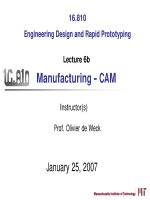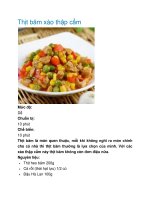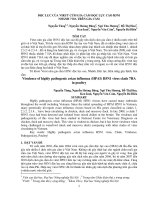Computer-aided manufacturing (CAM) potx
Bạn đang xem bản rút gọn của tài liệu. Xem và tải ngay bản đầy đủ của tài liệu tại đây (163.55 KB, 4 trang )
Computer-aided manufacturing (CAM) is the use of computer software to control machine
tools and related machinery in the manufacturing of workpieces.
[1][2][3][4][5]
This is not the only
definition for CAM, but it is the most common;
[1]
CAM may also refer to the use of a computer
to assist in all operations of a manufacturing plant, including planning, management,
transportation and storage.
[6][7]
Its primary purpose is to create a faster production process and
components and tooling with more precise dimensions and material consistency, which in some
cases, uses only the required amount of raw material (thus minimizing waste), while
simultaneously reducing energy consumption.
[citation needed]
CAM is a subsequent computer-aided process after computer-aided design (CAD) and
sometimes computer-aided engineering (CAE), as the model generated in CAD and verified in
CAE can be input into CAM software, which then controls the machine tool.
[3]
Overview
Traditionally, CAM has been considered as a numerical control (NC) programming tool, wherein
two-dimensional (2-D) or three-dimensional (3-D) models of components generated in CAD
software are used to generate G-code to drive computer numerically controlled (CNC) machine
tools. Simple designs such as bolt circles or basic contours do not necessitate importing a CAD
file.
As with other “Computer-Aided” technologies, CAM does not eliminate the need for skilled
professionals such as manufacturing engineers, NC programmers, or machinists. CAM, in fact,
leverages both the value of the most skilled manufacturing professionals through advanced
productivity tools, while building the skills of new professionals through visualization,
simulation and optimization tools.
[edit] History
The first commercial applications of CAM were in large companies in the automotive and
aerospace industries for example UNISURF in 1971 at Renault for car body design and tooling.
[citation needed]
Historically, CAM software was seen to have several shortcomings that necessitated an overly
high level of involvement by skilled CNC machinists. Fallows created the first CAM software
but this had severe shortcomings and was promptly taken back into the developing stage.
[citation
needed]
CAM software would output code for the least capable machine, as each machine tool
control added on to the standard G-code set for increased flexibility. In some cases, such as
improperly set up CAM software or specific tools, the CNC machine required manual editing
before the program will run properly. None of these issues were so insurmountable that a
thoughtful engineer or skilled machine operator could not overcome for prototyping or small
production runs; G-Code is a simple language. In high production or high precision shops, a
different set of problems were encountered where an experienced CNC machinist must both
hand-code programs and run CAM software.
Integration of CAD with other components of CAD/CAM/CAE Product lifecycle management
(PLM) environment requires an effective CAD data exchange. Usually it had been necessary to
force the CAD operator to export the data in one of the common data formats, such as IGES or
STL, that are supported by a wide variety of software. The output from the CAM software is
usually a simple text file of G-code, sometimes many thousands of commands long, that is then
transferred to a machine tool using a direct numerical control (DNC) program.
CAM packages could not, and still cannot, reason as a machinist can. They could not optimize
toolpaths to the extent required of mass production. Users would select the type of tool,
machining process and paths to be used. While an engineer may have a working knowledge of g-
code programming, small optimization and wear issues compound over time. Mass-produced
items that require machining are often initially created through casting or some other non-
machine method. This enables hand-written, short, and highly optimized g-code that could not be
produced in a CAM package.
At least in the United States, there is a shortage of young, skilled machinists entering the
workforce able to perform at the extremes of manufacturing; high precision and mass
production
[citation needed]
. As CAM software and machines become more complicated, the skills
required of a machinist or machine operator advance to approach that of a computer programmer
and engineer rather than eliminating the CNC machinist from the workforce.
Typical areas of concern:
• High Speed Machining, including streamlining of tool paths
• Multi-function Machining
• 5 Axis Machining
• Feature recognition and machining
• Automation of Machining processes
• Ease of Use
[edit] Overcoming historical shortcomings
Over time, the historical shortcomings of CAM are being attenuated, both by providers of niche
solutions and by providers of high-end solutions. This is occurring primarily in three arenas:
1. Ease of use
2. Manufacturing complexity
3. Integration with PLM and the extended enterprise
Ease in use
For the user who is just getting started as a CAM user, out-of-the-box capabilities
providing Process Wizards, templates, libraries, machine tool kits, automated feature
based machining and job function specific tailorable user interfaces build user confidence
and speed the learning curve.
User confidence is further built on 3D visualization through a closer integration with the
3D CAD environment, including error-avoiding simulations and optimizations.
Manufacturing complexity
The manufacturing environment is increasingly complex. The need for CAM and PLM
tools by the manufacturing engineer, NC programmer or machinist is similar to the need
for computer assistance by the pilot of modern aircraft systems. The modern machinery
cannot be properly used without this assistance.
Today's CAM systems support the full range of machine tools including: turning, 5 axis
machining and wire EDM. Today’s CAM user can easily generate streamlined tool paths,
optimized tool axis tilt for higher feed rates and optimized Z axis depth cuts as well as
driving non-cutting operations such as the specification of probing motions.
Integration with PLM and the extended enterprise
Today’s competitive and successful companies have used PLM to integrate
manufacturing with enterprise operations from concept through field support of the
finished product.
To ensure ease of use appropriate to user objectives, modern CAM solutions are scalable
from a stand-alone CAM system to a fully integrated multi-CAD 3D solution-set. These
solutions are created to meet the full needs of manufacturing personnel including part
planning, shop documentation, resource management and data management and
exchange.
[edit] Machining process
Most machining progresses through four stages, each of which is implemented by a variety of
basic and sophisticated strategies, depending on the material and the software available. The
stages are:
Roughing
This process begins with raw stock, known as billet, and cuts it very roughly to shape of
the final model. In milling, the result often gives the appearance of terraces, because the
strategy has taken advantage of the ability to cut the model horizontally. Common
strategies are zig-zag clearing, offset clearing, plunge roughing, rest-roughing.
Semi-finishing
This process begins with a roughed part that unevenly approximates the model and cuts
to within a fixed offset distance from the model. The semi-finishing pass must leave a
small amount of material so the tool can cut accurately while finishing, but not so little
that the tool and material deflect instead of shearing. Common strategies are raster
passes, waterline passes, constant step-over passes, pencil milling.
Finishing
Finishing involves a slow pass across the material in very fine steps to produce the
finished part. In finishing, the step between one pass and another is minimal. Feed rates
are low and spindle speeds are raised to produce an accurate surface.
Contour milling
In milling applications on hardware with five or more axes, a separate finishing process
called contouring can be performed. Instead of stepping down in fine-grained increments
to approximate a surface, the workpiece is rotated to make the cutting surfaces of the tool
tangent to the ideal part features. This produces an excellent surface finish with high
dimensional accuracy.
[edit] Software
See also: List of CAM companies and :Category:Computer-aided manufacturing software
The 10 largest CAM software products and companies, by end-user payments in year 2008
[8]
are,
sorted alphabetically:
• CATIA from Dassault Systèmes
• Cimatron from Cimatron group
• Edgecam from Planit, formerly Pathtrace
• Mastercam from CNC Software
• NX from Siemens PLM Software
• Powermill from Delcam
• Pro/E from PTC
• Space-E/CAM from NDES
• Tebis from Tebis AG
• WorkNC from Sescoi
Other CAM products and companies are Alphacam, BobCAD, CAMWorks, Dolphin, ESPRIT,
GCAM, GIBcam, GibbsCAM, GoElan, MazaCAM, MetaCAM, OneCNC, SolidCAM,
SprutCAM, SUM3D, SurfCAM, T-FLEX, TopSolid, VisualMILL, and VoluMill.
See also
• Computer-integrated manufacturing (CIM)
• Direct numerical control (DNC)
• Flexible manufacturing system (FMS)
• Integrated Computer-Aided Manufacturing (ICAM)
• Manufacturing process management (MPM)
• STEP-NC
• Rapid prototyping and rapid manufacturing - solid freeform fabrication direct from CAD models
[edit] References
1. ^
a
b
U.S. Congress, Office of Technology Assessment (1984), Computerized manufacturing
automation, DIANE Publishing, p. 48, ISBN 9781428923645, />id=LYdF5akRL6sC&pg=PA48.
2. ^ Hosking, Dian Marie; Anderson, Neil (1992), Organizational change and innovation, Taylor &
Francis, p. 240, ISBN 9780415063142, />id=TbwOAAAAQAAJ&pg=PA240.
3. ^
a
b
Daintith, John (2004), A dictionary of computing (5 ed.), Oxford University Press, p. 102,
ISBN 9780198608776, />4. ^ Kreith, Frank (1998), The CRC handbook of mechanical engineering, CRC Press, p. 15-1,
ISBN 9780849394188, />5. ^ Matthews, Clifford (2005), Aeronautical engineer's data book (2nd ed.), Butterworth-
Heinemann, p. 229, ISBN 9780750651257, />id=5W9Rqq3qP1QC&pg=PA229.
6. ^ Pichler, Franz; Moreno-Díaz, Roberto (1992), Computer aided systems theory, Springer, p. 602,
ISBN 9783540553540, />7. ^ Boothroyd, Geoffrey; Knight, Winston Anthony (2006), Fundamentals of machining and
machine tools (3rd ed.), CRC Press, p. 401, ISBN 9781574446593,
/>8. ^ Desktop Engineering,CAM Software Market Leaders
[edit] External links
• Dragomatz and Mann reviewed toolpath algorithms in 1997.
• Pocket Machining Based on Offset Curves by Martin Held
• Purdue University Purdue Research and Education Centre for Information Systems in
Engineering









